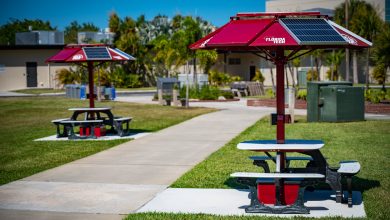Space 3.0: 58 Years of Space Flight – What’s Next?
By Stephanie R. Herndon ’07
Space 1.0:
Humans in Space—Feats of Engineering
On April 12, 1961, Yuri Gagarin became the first human to travel to space. He, alone in his 7-foot space capsule, Vostok 1, made humankind’s first orbit around the planet in 89 minutes.
Just weeks later, Alan Shepard flew Mercury Freedom 7 in a suborbital flight, followed by John Glenn’s orbital flight aboard Mercury-Atlas 6 in 1962.
That year, rocket technology pioneer and past Florida Tech commencement speaker Wernher von Braun backed the idea of a lunar orbit rendezvous mission. Von Braun’s dream was realized by the Apollo program, which enabled 12 astronauts to walk on the surface of the moon.
Humans in space? Check.
Space 2.0:
Exploration in Space—Feats of Science
Mariner 9 ushered in a new age in spaceflight: the first mission to explore beyond Earth’s orbit. Set to study Mars, the unmanned spacecraft launched May 30, 1971, soon followed by Pioneer 10 and 11, with sights set on reaching Jupiter and, years later, Saturn.
Meanwhile, the first missions of international cooperation, the Apollo-Soyuz Test Project, launched in 1975 to carry astronauts and cosmonauts to Skylab, the first U.S. space station and home to nearly 300 experiments.
Following Skylab’s orbital decay in 1979, the 1980s ushered in the shuttle era, a 30-year span of missions for scientific discovery through a gamut of experiments aboard the shuttle itself and the International Space Station.
Exploration of space? Check.
Space 3.0:
Travel in Space—Feats of Enterprise
Now, the big question is, what’s next?
Commercial space endeavors are already a profitable business. The global space economy exceeded $414 billion last year, according to the Space Foundation. Most of that amount was accounted for in satellite communications (SATCOM): mapping, GPS, weather forecasting, radio and more.
But getting to that point of revenue was a long and rocky road, according to Andy Aldrin, director of Florida Tech’s Center for Space Entrepreneurship.
“In the late 90s, we had something happening that has some striking similarities to what’s going on today,” Aldrin says. “There were probably a dozen different massive [satellite] constellations, some of which, like Teledesic, were going to have 900 spacecraft in them.”
Of those dozens of companies that spent billions to build and launch these satellites, Aldrin says, only three constellations were actually built and deployed into space. Much of that business went bankrupt and sold for a small fraction of the investment.
“We’ve got a saying in the space business: ‘If you want to make a small fortune in space, start with a large one,’” Aldrin says.
While today’s SATCOM industry has many similarities to the bubble in the 90s, and with far more massive constellations planned—up to 20,000 spacecraft, Aldrin says—there are some important differences.
“You’ve got some individual entrepreneurs who are very much invested in this that weren’t really there in 2000,” Aldrin says. “Another difference is, obviously, technology—that you can build a spacecraft now for orders of magnitude less than what it cost to build a spacecraft before. The third is capital structure … the financing structure is really different and, I think, a lot healthier.”
These differences in today’s space economy impact the future of human spaceflight, as well.
When the shuttle program ended in 2011, the mainstream population was left wondering if U.S. progress toward the next era of human spaceflight was slowing down. However, throughout the shuttle program’s last decade, private aerospace companies on America’s west coast were quietly forming and growing.
First was Space Adventures Inc. in 1998, followed by Blue Origin in 2000. Then, SpaceX in 2002 and Virgin Galactic in 2004. Their goal? Space—on their terms: affordability, reliability and practicality for routine transport.
The Space Foundation estimates that one quarter of last year’s global spending on “space” went toward launch vehicles, as governments began contracting with dozens of private companies to make and launch rockets for ISS resupply missions and satellite launches. NASA, for example, has selected Boeing’s Starliner and SpaceX’s Crew Dragon capsule to transport U.S. crews to and from the space station in coming years and end the U.S.’s reliance on Russia to take our crews into space.
However, Virgin Galactic and SpaceX want to take things in another direction: recreational travel and tourism.
The Challenges
Although a vacation cruise through space instead of through sea with “ports of call” on the moon and Mars may seem far-fetched, perhaps it’s not as far off as one might think. In fact, Virgin Galactic has launched multiple successful test flights for what will be a 90-minute suborbital tour around the planet—for the bargain price of $250,000.
However, there are more factors than just getting there to consider before space vacations longer than Virgin Galactic’s quick jaunt become a reality.
Biologically, accounts from astronauts like Scott Kelly, who spent a year in space, have taught us much about the impact that sustained low or no gravity can have on the human body: blurred vision, kidney stones, loss of bone and muscle mass, gene expression levels and much more.
Psychologically, the effect Earth’s blue sky has on our circadian rhythm and mental health and the human interaction that even the most introverted people need are pivotal to human health and mortality.
As the prospect of suborbital trips, orbital trips, lengthy vacations and even permanent human civilizations off this planet become more plausible, as a species, we must consider the evolutionary processes humans will go through as a result.
Still, the technology must first catch up with the dream.
“You can’t really have a sustained presence in low-Earth orbit without both transportation and destination,” says Laura Seward Forczyk ’06, founder and owner of Astralytical, a space research and consulting company. “Right now, the only destination is the International Space Station. Once you have more transportation opportunities—once some of these other rockets start coming into action—they’ll need more destinations for them to get to.”
The Rewards
Colonies in space, on the moon, on an asteroid or on another planet “will naturally come to be,” Forczyk says. However, it won’t be for humans to flee Earth in search of a new home like the characters in “Wall-E” and other sci-fi movies do.
“Earth is what we’ve grown up with, what we know. Earth is the paradise,” Forczyk says. “There’s no other place in the entire solar system that is as perfect for us as Earth.”
In fact, it is a love for Earth that motivates some people to pursue space operations. In the 1960s, Princeton University physics Professor Gerard O’Neill asserted that future dwellings and industrial operations in space would not replace Earth as our home but would make Earth a better home.
After O’Neill ran calculations and dug into the impact that productivity, sourcing materials and more would have on space colonization, his 1974 paper, “The Colonization of Space,” in Physics Today concluded that if work is begun soon, nearly all of our industrial activity could be moved from Earth’s fragile biosphere within less than a century.
Not only would the technical imperatives of this kind of migration of people and industry into space likely encourage self-sufficiency, small-scale governmental units, cultural diversity and a high degree of independence, it would increase the ultimate size limit for the human race by at least 20,000 times and would do so without harming anyone or polluting anything, according to the paper.
O’Neill isn’t alone. People and companies are already trying to find ways to move manufacturing into space or low-gravity environments to get it away from Earth’s surface.
“If we can create space stations or space outposts that are doing the heavy lifting, we can use the resources of space,” Forczyk says. “We don’t have to be resigned to the way that we’ve destroyed our planet already. We can make a better planet here by using the space we have out there.”
The Implications
Like space tourism today, at first, air travel was only available to the very wealthy. But when the government realized that transporting mail across the country—a time-intensive effort in those days—would be much easier and faster if done by air, it invested in air travel for more than just passengers, providing society many more options much more affordably.
Likewise, opening options in space travel beyond government missions and 90-minute tourism experiences for the wealthiest of enthusiasts will eventually make space travel more affordable and, therefore, more accessible.
“NASA is trying to create the infrastructure to create a self-sustaining economy so we aren’t dependent on the ISS,” Forczyk says. “In order for companies to have the incentive to put their own resources into getting into space, there needs to be something in it for them: money.”
Private industry’s primary motivators today are business from government contracts for getting into space and for creating an actual settlement and potential profit from space tourism, however far off that may be. The business-to-business opportunities for things that space-dwelling civilizations will need—propellant, cement, raw materials, 3D printing, radiation shielding, even water—will follow.
“And one of the great things is we don’t even have to imagine it all right now,” Forczyk says. “There are applications we have no idea are out there and coming that no one has thought of yet.”
Much like cellphones, which were only capable of making phone calls before innovators added cameras, music players, Wi-Fi, games, apps and so much more throughout the last 40 years, space travel will evolve as humans capitalize on the opportunities that arise.
We’re already seeing that ingenuity at play with remote-sensing satellites. Originally used for basic observation, reconnaissance and communication, today they have millions of applications spanning industries from law enforcement and emergency services to agriculture and more.
“You have a platform, you have a technology, and the creativity of humanity will come up with additional applications for it,” Forczyk says. “It’s that kind of application that we don’t have to predict. Human ingenuity will get there eventually.”
This story was featured in the Fall 2019 f Florida Tech Magazine. Read the full magazine here.




